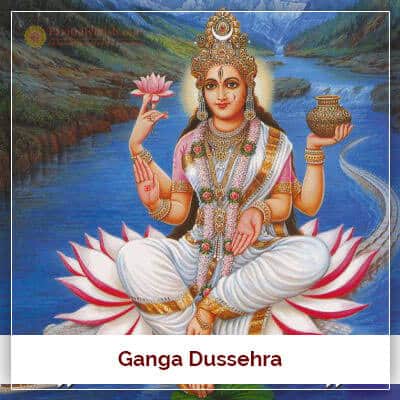Ganga Dussehra
Published On : June 30, 2022 | Author : Astrologer Pt Umesh Chandra Pant 
About Ganga Dussehra
This is one of the most sanctimonious and auspicious festivals in Hindu religion. This festival is celebrated in the utmost reverence dedicated to Goddess Mata Ganga on the auspicious day of Dashami of Shukla Paksha in Jyeshtha month. Because of this festival being celebrated on Dashami Tithi and its connection with the river Ganga, it is known as Ganga Dussehra. Like every year, the festival is slated for its celebration this year 2020 on the 1st June of Monday. The festival is especially celebrated on the banks of Ganga at the pilgrimage site of Haridwar, Varanasi, and Prayag. The life coursing through the world happens due to this festival. Celebration of the festival is observed in an honor to birthing of Mother Ganga. Because it marks the appearance of Maa Ganga on earth followed by several eons of ceaseless meditation done by Bhagiratha to please Lord Shiva, who held unfathomable strength of Maa Ganga cascading straight from heaven, in His Jata (matted hair), and then happened the release of Bhagiratha’s 60,000 great-uncles from the curse of saint Kapila. Mother Ganga, even today, has been in pursuit of her goal of maintaining benevolence worldwide. Bringing Mother Ganga from the heaven to the earth by Gods is the reason she is also greeted as divine river.
Significance of bathing on Ganga Dussehra
On this festival, following rituals like taking bath, giving alms, holding meditation and Japa, and worships, at the holy water-reservoir, can deliver significant values to the devotees. Any religious activities done with utmost reverence, like bathing and alms-offering on this occasion at pilgrimage sites dedicated to Ganga give devotees auspicious results. No doubt water is life, but the holy water of Ganga is immortal to life. Merely by drinking this holly water can cause effective remedial cure to various types of diseases and skin-related ailments. Taking a bath in holy water of Ganga on Ganga Dussehra can be an effective solution in permanently abolishing at least 10 sins committed by humans, wittingly or unwittingly. Maa Ganga holds that divine omnipotence to absolve devotees of all those sins. Because, sins committed through cardinal action, such as foul-mouthing, and the sin committed through mental utterance of abuse for someone, are generally one of the categories of various sins. These types of sins are absolved after observing holy bath in the Ganga and doing offerings, worships and other rituals, religiously. In reference to this very pious significance of Ganga, Goswami Tulsidas wrote in his epic, Shri Ramcharitmanas: – To witness the sight of Ganga, taking bath in it and drinking its water can constitute absolution of all collective sins. Our Vedas and religious books have seconded this endorsement, deemed as the most appropriate reference, in this context.
Value O Alms-Donating During Ganga Dussehra
On Ganga Dussehra, besides the importance of Ganga-bath and drinking Ganga water, there is a revered importance of the incarnation of Mata Ganga on Earth during Shukla Dashami Tithi of Jyeshtha month and Hasta Nakshatra. On one hand, doing religious activities and worships at this divine river Ganga is deemed extremely valuable on various counts, on the other hand; it is equally valuable to donate corns, cloths, fruits, and foods of different varieties, Sattu made by chickpeas, sweets and money, to saints, abbots, learned Brahmans, and the poor.
Ganga Dussehra; Puja and Vrat
On Ganga Dussehra festival, puja & prayers are performed using a variety of rituals, involved to which is collection of all ingredients of Puja, reading Manglik Shlokas, invoking Lord Ganesha and other deities, again invoking Mata Ganga and then take an oath for vrat/fasting. Please see to it the rituals involved in this regard command that these resolutions should be followed after the devotee has done his daily routines like attending washroom etc. Take resolution of selfless worship after having taken the resolution/oath of vrat. Bathe Mata Ganga while reciting her. Thereafter, offer cloth, flowers, sandalwood, rice etc. After lighting incense sticks and Diya, offer fruits and sweets available to the deity Ganga. Pronounce mantras and strotas of Ganga, followed by properly ritual-wise worships. Or recite her mantras for ten times or more than that. Ganga is destroyer of all sins and sufferings. If you can’t read mantras in Sanskrit, follow Hindi-quoted verse of the same: My greetings to Mata Ganga, the deity seated on white crocodile, the deity endowed with three-eyes and four-hands, the deity adorned with pitcher and lotus, the deity dignified by fearless stance benefiting the devotees. I offer my greetings to such deity, who embodies Trident-form. Greetings to Mata Jhanvi, who ensconced herself in Jata of lord Shiva from the lotus of lord Brahma, then watering the feet of the lord, cascaded her course down on earth in ceaseless streams. I offer my greetings to such goddess! Thereafter, observe the Japa using mantra – ऊॅ नमः शिवायै नारायण्यै दशहरायै गंगायै नमः Make sure you offer some jaggery, corns or roll of flour to tortoise and fishes swimming in Ganga water. Both these aquatics embody divine forms of the Lord, hence symbolizing as entities to worship ritual-wise. This festival also increases the numerical value of number, 10. This means, one can donate things in numeric of 10, like 10 kg of wheats/oats or Tila oil to Brahmans.
Story of Ganga Dussehra: Story of Ganga Dussehra
Long time ago, King Sagar had conducted Ashwamedha Yagna. His grand-son, Anshuman was on guard of the yagna. As the fate had it, someone abducted his horse. The incident created stalemate for the yagna. On being informed of the incident, Anshuman set out his 60,000 soldiers, and himself with family members to search for the abducted horse throughout the earth. However, the horse was not found anywhere on the earth. When they extended their search to the Underground world (Patal Lok), the horse was found grazing around the place where Lord, saint Kapila was on meditation. People accompanying Anshuman shouted out, Thief! Thief! As a result, the meditation of the saint was disturbed and everyone, who contacted the enraged glaze of the saint, turned into ashes, instantly. To release all those dead souls from the curse of saint Kapila, Bhagiratha, the son of king Dilip, observed hard austerities for many years. He pleased Lord Brahma, who granted the boon to Ganga to incarnate on earth. However, the extremely mighty stream of Ganga was insufferable for the earth. Then Bhagiratha pleased Lord Shiva, who held Ganga in his Jata. On the request of saint Bhagirathi, lord Shiva granted a narrow opening of his Jata to the earth, resulting in Ganga cascading in ceaseless streams on the earth. And then Bhagirathi succeeded in absolving the sins of his forefathers through Ganga’s currents. They attained salvations. Bhagirathi, for his exemplary efforts to bring beneficial Ganga on earth to release his forefathers from the curse, became immortal, and is still revered in remembrance.
Ganga Dussehra and Beliefs
It is believed, according to Skanda Purana, that on the occasion of Ganga Dussehra, donating and doing religious activities, can absolve devotees of ten most sinful deeds. It is believed that those who can’t go to Haridwar for Ganga bath, should take bath in s sacred water reservoir and regularly offer water to Gods and Goddesses. Perform Tarpan ritual-wise. It eliminates all 10 grievous sins. Similarly, Bhavishya Purana describes that devotees who bath in Ganga with total dedication and offer Aachmana religiously with mantras would attain salvation from major sins. Devotees, regardless of poor or rich, can attain effectual results and elimination of all ten sins by reciting Ganga mantras religiously. Skanda purana says devotees who recite Ganga stotras religiously on Ganga Dussehra gain emancipation from temporal illusions and prosperity. Patients who recite Ganga mantras gain cure from diseases. For the stotras, buy the related book from a religious library or carry Ganga Dussehra stotram book. This is needed because religiously reading the stotras could neutralize the poison of materialistic charms. Munda samskara on this day is also believed on the bank of Ganga.
Must Read: Pradosh Vrat and Goddess Durga







